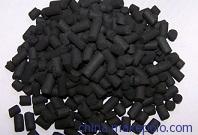

Activated Carbon Catalyst Support
活性炭重要用途之一是作催化剂载体和助催化剂,也可直接用作催化剂。载体活性炭是指催化剂负载在活性炭表面上,活性炭只是起到载体的作用。载体主要用于支持催化剂,使其具有特定的物理化学性能,而载体本身一般并不具有催化活性。常用的载体有活性氧化铝、粘土、分子筛、活性炭、蜂窝陶瓷、氧化硅、高岭土、硅藻土等。常用“活性组分名称-载体名称”来表明负载型催化剂的组成,如加氢用的钯-活性炭催化剂、汽车尾气净化用的铂-蜂窝陶瓷催化剂。
将活性炭浸渍在金属盐溶液中可使催化剂负载在活性炭表面上,活性炭表面氧化性、酸性官能团、电子授受能力、自由基、细孔结构、化学结构等都对活性组分的性能有影响。
活性炭具有不规则的石墨结构,其中含有微量的灰分、氮、硫、氢和氧等,这些成分会对催化剂的性能产生影响;灰分是载体活性炭一项重要指标;活性炭表面的C-O构造对氧化反应、卤代反应、吸附性能、电性能都有影响。
远影活性炭具有丰富的孔隙结构、特殊的电子性能、易于调控的表面基团、较高的比表面积、较强的耐酸、耐碱、耐高温等性质,用作催化剂载体时,可使活性组分的前驱体得到充分分散。活性炭本身具有催化活性,与活性组分之间相互作用会影响催化剂的活性与选择性,同时可以节省活性物质的用量。活性炭中担载有微量过渡金属时,与单独使用金属时相比,氢表现出明显的可逆吸附现象,这被称之为溢出(Spillover)现象。活性炭有粉末状和颗粒状两类,在气固相反应过程中,均用颗粒状活性炭为催化剂载体。活性炭的比表面虽然很高,但与活性氧化铝载体、蜂窝陶瓷载体、分子筛载体等比较,其机械强度较差。因此在生产活性炭载体时,其强度一般控制在95%以上。
贵金属催化剂用载体活性炭,粉状、柱状、球形、颗粒均可,如用作钯催化剂、钌催化剂、铑催化剂、铂催化剂等的载体。
One of important application of Activated Carbon is as catalyst support and promoter, also can be directly as catalyst. As a support, mainly used to support catalyst, lets catalyst load on its surface and makes it possess certain physical and chemical property, support itself generally does not have catalytic activity. Common supports include activated alumina, activated carbon, molecular sieve, clay, honeycomb ceramics, monox, kaolin, diatomite, etc. Usually used “active component-support name” to indicate supported catalyst composition, for example, Pd-activated carbon catalyst for hydrogenation, Pt-honeycomb ceramics catalyst for automotive exhaust purification.
Activated carbon impregnated with metal salts solution can make the catalyst load on the surface of activated carbon, activated carbon’s surface oxidation, acidic functional groups, electron accepting ability, free radicals, pore structure, chemical structure can affect the performance of the active component.
Activated carbon has the irregular graphite structure, in which includes traces of ash, nitrogen, sulfur, hydrogen, oxygen and so on, these ingredients can have the influence to the catalyst performance; Ash is an important indicator of support activated carbon; C-O structure on the surface of activated carbon will affect oxidizing reaction, halogenating response, adsorption performance and electricity performance.
Due to Yuanying activated carbon has abundant pore structure, special electronic properties, easy to regulate surface groups, high specific surface area, strong acid-resistant, alkali-resistant and heat-resistant properties, when used as a catalyst support, the precursor of active component is fully dispersed. Activated carbon itself has catalytic activity, interaction with active component can affect the activity and selectivity of the catalyst, and can save the quantity of active substance. Compare with using metal alone, when activated carbon supports trace amounts of transition metals, hydrogen shows obvious reversible adsorption phenomenon, this called overflow spillover phenomenon.
Activated carbon includes powder and granule, in the process of gas-solid reaction, all used granule activated carbon as catalyst support. Although activated carbon’s specific surface area is very high, but compare with activated alumina support, honeycomb ceramics support and molecular sieve support, its mechanical strength is lower. Therefore, in the production process, commonly activated carbon’s strength is controlled above 95%.
Precious metal catalyst includes Pd catalyst, Ru catalyst, rhodium catalyst, Pt catalyst, etc. As precious metal support, activated carbon shape can be powder, cylinder, sphere and granule.
Application
(1) Isomerization: Ni-Carbon catalyst can let plant oil isomerization (cottonseed oil, linseed oil, rapeseed oil, etc.), from non-conjugated oil into conjugated forms;
(2) Hydrogenation, dehydrogenation and dehydrogenation of aromatization, cyclization and isomerization: Pd-activated carbon catalyst or Pt-activated carbon catalyst can play this catalytic role;
(3) Low pressure polymerization of olefins: Activated carbon loads on Ni, Co or their oxide can let olefin polymerization;
(4) Synthetic fibre: In the production of vinylon, activated carbon impregnated zinc acetate can let acetylene and acetic acid synthetise vinyl acetate;
(5) Gum Rosin reprocessing: Activated carbon loads on Pd can produce hydrogenated rosin and disproportionated rosin;
(6) Synthesis of vinyl chloride: Activated carbon loads on mercuric chloride can let acetylene and hydrogen chloride synthetise vinyl chloride.





